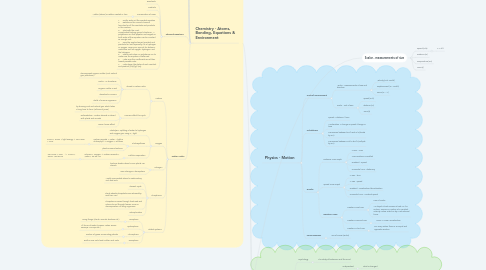
1. Chemistry - Atoms, Bonding, Equations & Environment
1.1. Atoms
1.1.1. Building blocks of matter
1.1.2. Protons - positive sub-particle found in nucleus
1.1.3. Neutrons - neutral sub-particle found in nucleus
1.1.4. Electrons - negative sub-particle found in shells
1.1.5. Mass Number = protons + neutrons
1.1.6. Atomic Number = number of protons
1.2. Periodic Table of Elements
1.2.1. Elements are ordered by atomic number
1.2.2. Rows of periodic table called PERIODs
1.2.3. Columns of periodic table called GROUPs
1.3. Electron Configuration
1.3.1. Filling Rules for first 20 elements: 2, 8, 8, 2
1.3.2. Shell capacity: 2, 8, 18, 32
1.4. Ions
1.4.1. Charged particles
1.4.2. Anions - negative ions
1.4.3. Cations - positive ions
1.4.4. Metallic Bonding
1.4.4.1. metal + metal
1.4.4.2. positive cations with sea of valence electrons
1.5. Bonding
1.5.1. Covalent Bonding
1.5.1.1. non-metal + non-metal
1.5.1.2. sharing of valence electrons
1.5.2. Ionic Bonding
1.5.2.1. non-metal + metal
1.5.2.2. gain or loss of electrons to form negative and positive ions that are attracted to each other
1.6. Chemical Equations
1.6.1. Reactants
1.6.2. Products
1.6.3. Conservation of mass
1.6.3.1. Matter (atoms) is neither created or loss
1.6.4. 1. Firstly, write out the worded equation 2. Determine the correct chemical formulas for all the reactants and products in the reaction. 3. Start with the most complicated-looking group to balance. A polyatomic ion that appears unchanged on both sides of the equation can be counted as a single unit. 4. Save the single element reactant and products for last, especially if it is hydrogen or oxygen. Keep your eye out for diatomic molecules such as oxygen, hydrogen, and the halogens. 5. Check each atom or polyatomic ion to make sure the equation is balanced 6. Make sure the coefficients are at their lowest possible ratio. 7. Write down the states of each reactant and product (l)/(s)/(g)/ (aq).
1.7. Matter Cycles
1.7.1. Carbon
1.7.1.1. Stored in carbon sinks
1.7.1.1.1. decomposed organic matter (coal, natural gas, petroleum)
1.7.1.1.2. Rocks - i.e limestone
1.7.1.1.3. Organic matter in soil
1.7.1.1.4. dissolved in oceans
1.7.1.1.5. shells of marine organisms
1.7.1.2. Humans affect this cycle
1.7.1.2.1. by burning coal and natural gas, which takes a long time to form (millions of years)
1.7.1.2.2. Deforestation - carbon dioxide is stored with plants and animals
1.7.1.2.3. Green house effect
1.7.2. Oxygen
1.7.2.1. Photolysis - splitting of water to hydrogen and oxygen gas, using UV light
1.7.2.2. Photosynthesis
1.7.2.2.1. Carbon Dioxide + Water ---light & Chlorophyll--> Oxygen + Glucose
1.7.2.2.2. plants & some bacteria
1.7.2.3. Cellular Respiration
1.7.2.3.1. Glucose + Oxygen -> Carbon Dioxide + Water + 36-38 ATP
1.7.3. Nitrogen
1.7.3.1. bacteria breaks down to ions plants can absorb
1.7.3.2. main storage in atmosphere
1.7.4. Phosphorus
1.7.4.1. Mostly inaccessible stored in sedimentary rock and soils
1.7.4.2. Slowest Cycle
1.7.4.3. Plants absorb phosphate ions released by rock from rain
1.7.4.4. Phosphorus moves through food web and returns to soil through faeces, urine or decomposition of living organisms
1.7.4.5. eutrophication
1.7.5. Global Systems
1.7.5.1. Biosphere
1.7.5.1.1. Living things (Plants, animals, bacteria etc.)
1.7.5.2. Hydrosphere
1.7.5.2.1. All forms of water (Oceans, Lakes, Rivers, Swamps, ice caps etc.)
1.7.5.3. Atmosphere
1.7.5.3.1. mixture of gases surrounding planets
1.7.5.4. Geosphere
1.7.5.4.1. Earth's core, solid and molten rock, soils
2. Scalar - measurements of size
2.1. Speed (m/s)
2.1.1. S = d/t
2.2. Distance (m)
2.3. Temperature (oC)
2.4. Time (s)
3. Physics - Motion
3.1. Units of Measurement
3.1.1. Vector - measurements of size and direction
3.1.1.1. Velocity (m/s, North)
3.1.1.2. Displacement (m , South)
3.1.1.3. Force (N , ->)
3.1.2. Scalar - unit of size
3.1.2.1. Speed (m/s)
3.1.2.2. distance (m)
3.1.2.3. Time (s)
3.2. Calculations
3.2.1. Speed = distance / time
3.2.2. Acceleration = change in speed /change in time
3.2.3. Conversion between km/h and m/s (divide by 3.6)
3.2.4. Conversion between m/s to km/h (multiple by 3.6)
3.3. Graphs
3.3.1. Distance Time Graph
3.3.1.1. X-axis - Time
3.3.1.2. Y-axis Distance Travelled
3.3.1.3. Gradient - Speed
3.3.1.4. Horizontal Line - stationary
3.3.2. Speed Time Graph
3.3.2.1. X-axis - time
3.3.2.2. Y- axis - speed
3.3.2.3. Gradient - acceleration/decceleration
3.3.2.4. Horizontal Line - constant speed
3.3.3. Newton's Laws
3.3.3.1. Newton's First Law
3.3.3.1.1. Law of Inertia
3.3.3.1.2. An object at rest remains at rest, or if in motion, remains in motion at a constant velocity unless acted on by a net external force.
3.3.3.2. Newton's Second Law
3.3.3.2.1. Force = mass x acceleration
3.3.3.3. Newton's Third Law
3.3.3.3.1. For every action there is an equal and opposite reaction
3.4. Force Diagrams
3.4.1. use of arrow (vector)
4. Psychology- Sport
4.1. Psychology
4.1.1. The study of behaviour and the mind
4.2. Research Methods
4.2.1. Variables
4.2.1.1. Independent
4.2.1.1.1. what is changed
4.2.1.2. Dependent
4.2.1.2.1. what is measured
4.2.1.3. Extraneous /Confounding
4.2.1.3.1. coincidental changes, uncontrolled variables
4.2.1.4. Control
4.2.1.4.1. what is kept the same to keep results more reliable
4.2.2. 2 + Groups
4.2.2.1. Control Group
4.2.2.1.1. baseline testing
4.2.2.2. Experimental Group
4.2.3. Fair Testing
4.2.3.1. Random Allocation of Participants to Sample
4.2.3.2. Sample participants must represent the population
4.2.3.3. All extraneous and confounding variables controlled
4.2.4. Methods:
4.2.4.1. Experimental Methods
4.2.4.1.1. lab experiments
4.2.4.1.2. field experiments
4.2.4.2. Non-Experimental Methods
4.2.4.2.1. survey
4.2.4.2.2. observation
4.3. Psychological Techniques
4.3.1. Motivation
4.3.1.1. intrinsic
4.3.1.1.1. motivation from self/within
4.3.1.2. extrinsic
4.3.1.2.1. motivation by external pressure
4.3.2. Stress/Arousal Response
4.3.2.1. Physiological Changes:
4.3.2.1.1. increase heart rate
4.3.2.1.2. increase breathing rate
4.3.2.1.3. decrease digestive processes
4.3.2.1.4. liver releases glucose for energy
4.3.2.2. Yerk Dodson Graph (Performance versus Arousal)
4.3.2.3. Arousal Level for optimum performance depends on sport
4.3.2.4. Music Tempo
4.3.3. Mental Rehersal
4.3.3.1. mentally/visualising or practicing the particular process/action
4.3.4. Visualisation\Imagery
4.3.4.1. visualising crowd, feeling of winning etc.

